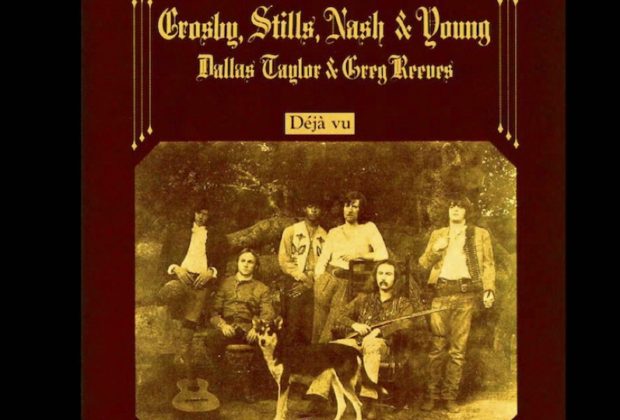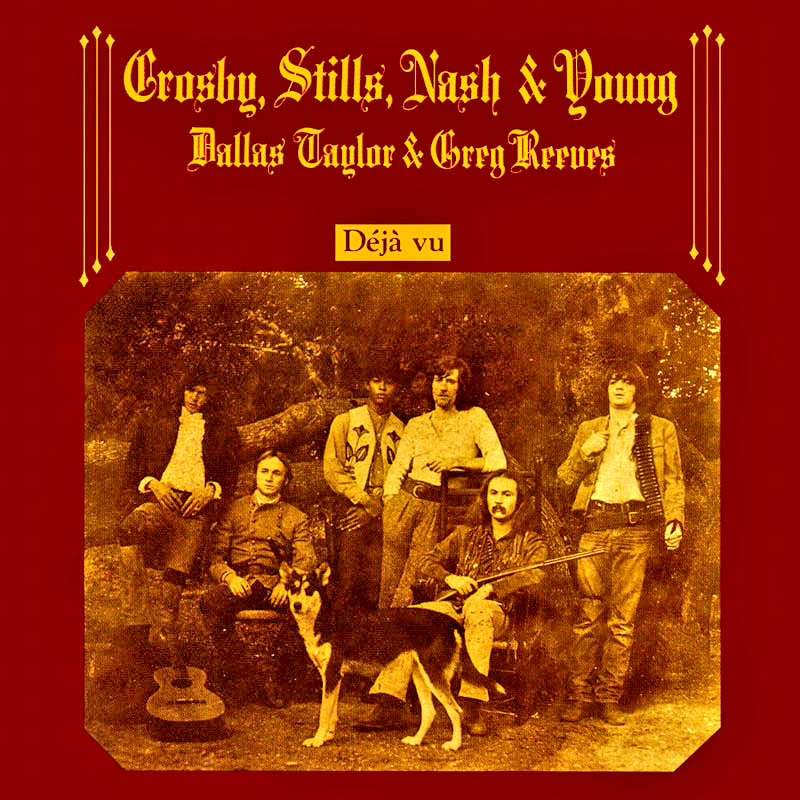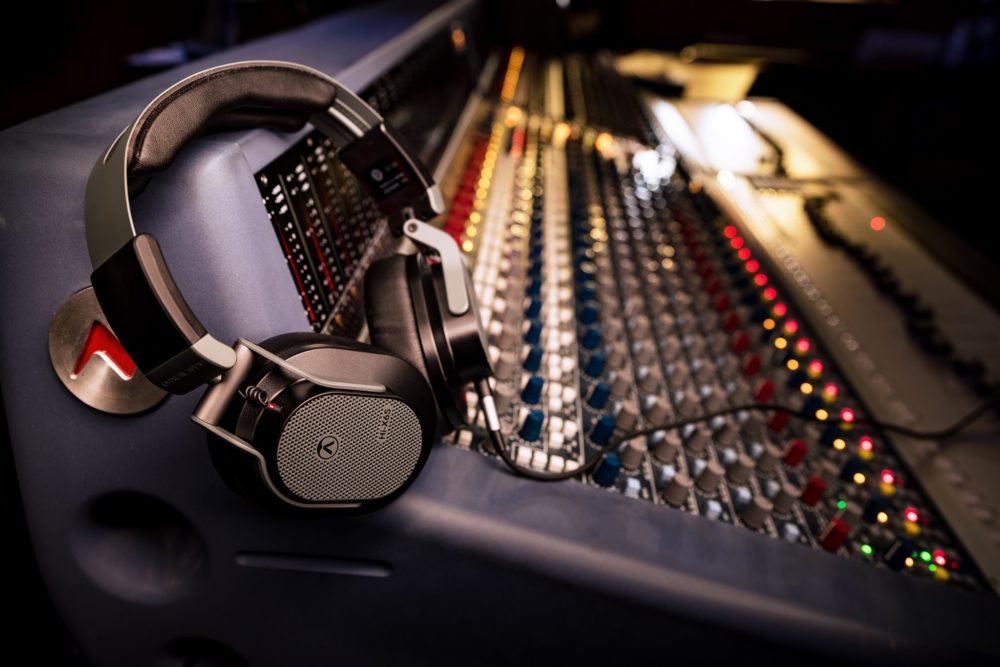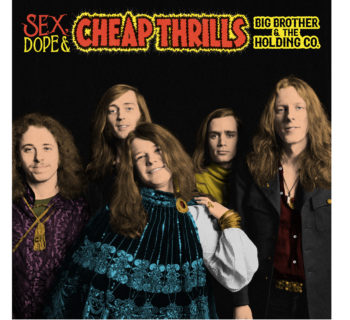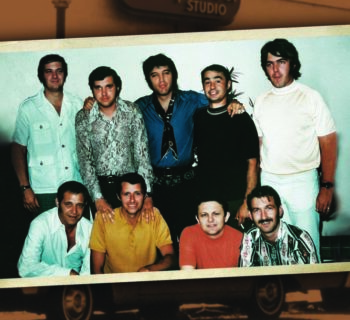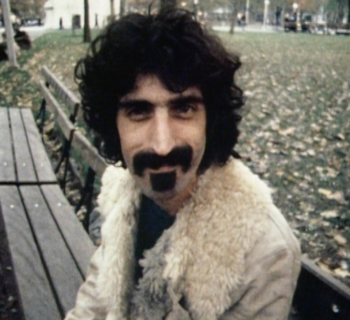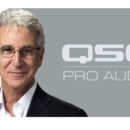Crosby, Stills, Nash & Young’s Déjà Vu was the most-anticipated new album in America in 1970. More than 50 years later, it’s one of the most famous albums in rock history with legendary songs, including “Carry On” and “Teach Your Children,” that still resonate today.
Rhino will honor the intense creative journey that led to this milestone album with an expansive 4-CD/1-LP collection that includes a pristine version of the original album on both 180-gram vinyl and CD, plus hours of rare and unreleased studio recordings that provide incredible insight into the making of the record.
DÉJÀ VU: 50TH ANNIVERSARY DELUXE EDITION will be available from Rhino on May 14 for $99.98. Presented in a 12 x 12 hardcover book, the collection comes illustrated with rarely seen photos from the era and annotated by writer/filmmaker Cameron Crowe, whose revealing liner notes recount the making of the album through stories told by the people who were there, including David Crosby, Stephen Stills, Graham Nash, and Neil Young.
In the new anniversary edition, the album’s original 10 tracks are joined by 38 more to add nearly two-and-a-half hours of music that includes demos, outtakes, and alternate takes – most of which are previously unreleased. Among them is “Know You Got To Run,” the first song the quartet recorded during its first session on July 15 at the house Stills was renting from Peter Tork in Studio City.
Other unreleased highlights include the demo for Crosby’s “Almost Cut My Hair”; Stills’ outtake for “Bluebird Revisited”; and Young’s alternate version of “Helpless” featuring harmonica. Also making its debut on the set is a version of “Our House” that features Nash singing with the song’s inspiration, Joni Mitchell.
DÉJÀ VU: 50th ANNIVERSARY DELUXE EDITION
4-CD/1-LP Track Listing
Disc One: Original Album
- “Carry On”
- “Teach Your Children”
- “Almost Cut My Hair”
- “Helpless”
- “Woodstock”
- “Déjà Vu”
- “Our House”
- “4 + 20”
- “Country Girl”
- “Whiskey Boot Hill”
- “Down, Down, Down”
- “Country Girl” (I Think You’re Pretty)
- “Everybody I Love You”
Disc Two: Demos
- “Our House” – Graham Nash *
- “4 + 20” – Stephen Stills *
- “Song With No Words (Tree With No Leaves)” – David Crosby & Graham Nash
- “Birds” – Neil Young & Graham Nash *
- “So Begins The Task/Hold On Tight” – Stephen Stills *
- “Right Between The Eyes” – Graham Nash
- “Almost Cut My Hair” – David Crosby *
- “Teach Your Children” – Graham Nash & David Crosby
- “How Have You Been” – Crosby, Stills & Nash
- “Triad” – David Crosby
- “Horses Through A Rainstorm” – Graham Nash
- “Know You Got To Run” – Stephen Stills *
- “Question Why” – Graham Nash *
- “Laughing” – David Crosby *
- “She Can’t Handle It” – Stephen Stills *
- “Sleep Song” – Graham Nash
- “Déjà Vu” – David Crosby & Graham Nash *
- “Our House” – Graham Nash & Joni Mitchell *
Disc Three: Outtakes
- “Everyday We Live” *
- “The Lee Shore” – 1969 Vocal *
- “I’ll Be There” *
- “Bluebird Revisited” *
- “Horses Through A Rainstorm”
- “30 Dollar Fine” *
- “Ivory Tower” *
- “Same Old Song” *
- “Hold On Tight/Change Partners” *
- “Laughing” *
- “Right On Rock ’n’ Roll” *
Disc Four: Alternates
- “Carry On” – Early Alternate Mix *
- “Teach Your Children” – Early Version *
- “Almost Cut My Hair” – Early Version *
- “Helpless” – Harmonica Version
- “Woodstock” – Alternate Vocals *
- “Déjà Vu” – Early Alternate Mix *
- “Our House” – Early Version *
- “4 + 20” – Alternate Take 2 *
- “Know You Got To Run” *
LP: Original Album
Side One
- “Carry On”
- “Teach Your Children”
- “Almost Cut My Hair”
- “Helpless”
- “Woodstock”
Side Two
- “Déjà Vu”
- “Our House”
- “4 + 20”
- “Country Girl”
- “Whiskey Boot Hill”
- “Down, Down, Down”
- “Country Girl” (I Think You’re Pretty)
- “Everybody I Love You”
- * Unreleased
In August 1969 my brother Kenny and I attended the debut of CSN&Y at the Greek Theater in Los Angeles. It was a groovy event.
“It was a different band when Neil joined,” Graham Nash explained to me in a 2014 interview we conducted for Record Collector News.
“Crosby, Stills, Nash and Young are a completely different band than CS&N. And not a lot of people understand that. They think it’s just an added voice. But it’s not. It’s an added attitude. Neil brings a sharper edge. I was gonna say a darker feeling but I don‘t mean that in a negative way. He brings this edge to us that we don’t have. And, of course, you have to take into account his ability to play lead guitar against and with Stephen.”
During the fall of 1969, CSN&Y navigated between the stage and the studio. They combined a US tour with the recording of their initial album as a quartet. Déjà Vu was issued in 1970 on March 11th 1970. It soared to the top of the charts.
Engineer Bill Halverson already had an established history with Atlantic Records before he did the Crosby, Stills & Nash album at Wally Heider’s studio in Hollywood and was subsequently drafted for Déjà Vu.
“I was leaving Wally Heider’s and cleaning up and [manager] Eliott Roberts walked in and said, ‘The guys have started their next album without you and really want you to come on up and be the engineer,” remembered Halverson in an interview we did earlier this century.
“The last day I was at Heider’s was on a Friday, and the following Monday I walked into a studio C Heider’s in San Francisco for the first time.
“About Crosby’s ‘Almost Cut My Hair.’ I had learned a trick when recording Cream in San Francisco with double stacks of Marshall amps where if I aim the mike right the amp actually acts as a baffle.
“Déjà Vu was a lot harder than the first one. For CS&N they rehearsed for three months and went ahead and recorded it. Neil is now in the band adding a new dynamic. A lot of ‘Woodstock’ was already recorded, some of Neil‘s stuff was already recorded when I got there. I did three weeks up in San Francisco and we moved to Hollywood at Heider’s. And then Neil would take the tapes, he didn’t like what we were doing, and he’d go to his house, or to Glendale to Whitney Studios to put that pipe organ on.
“I did some of the overdubs on ‘Helpless.’ We mixed Déjà Vu at Heiders. Neil didn’t like our mixes, ‘cause it was CSN vocals with Neil, and so he’d go mix them on his own, and you’d listen to ‘Helpless’ and ‘Country Girl’ and it sounds like Neil Young with background singers,” underscored Halverson.
“A lot of people were disappointed with Déjà Vu from their previous studio outing,” offered Dr. James Cushing, a former KEBF-FM deejay.
“Neil really wasn’t really collaborating or recording with the band. There was a dark cloud around that album as Graham Nash has discussed.
“And I also thought that Déjà Vu had a little bit of the Beatles White album syndrome in terms of it being much more individual peoples work than a group effort. I loved ‘Helpless.’ I loved how much of a true Neil Young song it was in the middle of the chaos of that group disc. It kind gave the lie to the group, you know, like it was supposed to be a unified group. It wasn’t. This was a Neil Young song on that album the way ‘Julia’ was a John Lennon song.
“Neil was never a team player and this is another example. From what I understand he did his own tracks away from the CS&N, down the hallway or in Northern California. You got the sense Neil was saving the best stuff for a solo album but this one leaked out.”
“He’s always had an agenda,” admitted Graham Nash. “When we were rehearsing the Deja Vu record at Stephen’s house in Laurel Canyon, at the bottom of Laurel Canyon there, he would leave rehearsals and go to the studio and he’d be recording After The Gold Rush.
“I always allowed people to do what the fuck they want. The only time that I ever got really upset with Neil was during the Deja Vu record and Neil would bring tapes in from his studio, we would put voices on, he would take them back to his studio, and he would mix them and it was all a separate thing.
“Neil’s songs on the Déjà Vu record were done by Neil and Neil’s studio when he got our voices and our instruments on at Wally Heider’s in San Francisco.
“At some point that and a bunch of other things, including too much cocaine, I ended up in the studio, and I said, ‘you know what, we’re fuckin’ blowing this. We are blowing this. We are so good and we have so many great songs and we are fucking blowing this.’
“Stills is in the studio until 6:00 every fuckin’ morning, you know, getting to the studio later and later. I was getting angry about it, don’t forget, I was not with Joan, Stephen was not with Judy [Collins], David had lost Christine [Hinton]. I just remember bursting out into tears. Because I felt we were completely blowing something. And the thing that we were blowing had been given to us by the Gods.”
In April 2021 I interviewed David Crosby about CSN&Y origins, the influence of jazz on his own songwriting, the impact of Neil Young joining CSN&Y for Déjà Vu and reflections on some of his tunes appearing in demo form on this 50th anniversary reissue.
“The greatest strength we had was as songwriters,” explained Crosby. “That was our main number one strength. And the trick that we had was that we had several. Now most bands had one. Some had two. What that gets you is that if you are painting a picture and you have a number of colors on your palate, if you are working with somebody else they have different colors on their palate. If they have six and they have nine, all of a sudden you have sixteen colors. It’s a better painting.
“Now, when you are making albums, the problem of having one writer is that he or she tends to write very similarly song to song. With the four of us we had four drastically different writing styles, four ways of conceiving a song. They were very different,” stressed David.
“Now I will go out on a limb and say Stills was the best of us. I think he was, without question, the best songwriter, the best singer and the best guitar player. All three. But I think all four of us had real skill as songwriters and our stuff was very different than each other. I think that’s one of the main reasons that it made it.”
I asked Crosby about Neil Young joining the already established CS&N trio.
“I’ll tell you exactly. I was sittin’ in Joni’s driveway on Lookout Mountain Drive in Laurel Canyon. And Neil drove by and he saw me out there, turned around at the next stop and came back down and pulled in. Gets out of his car and pulls out a guitar.
“Now this is when we are considering asking him to be in the group. And he knows that. He knows that Nash is against it. And he knows I’m kind of on the fence, and he knows Stills is for it. That kind of makes me the decider. I didn’t say anything. That’s how it was, right? Neil sat down on the trunk of the car with me, the two of us, him with the guitar, and he sang ‘Helpless,’ ‘Country Girl’ and a few other things. And I said ‘I wanna work with this guy. This is too good.’ It was about the writing. It was all about those songs.
“He’s not as good as a guitar player as Stills,” suggested Crosby. “To this day he’s not as good as a guitar player as Stills. He’s very very good. Stills is very much better. We didn’t need him for that. We did need a guitar player when Stills was playing keyboard. And that was a big factor in what Stills said to us about bringing Neil in. But, for me, it was only about those songs. They were excellent. Excellent. And they were completely different from us and I knew what would happen when we add those Crosby, Stills, Nash vocal sound to a song like that. I knew what ‘Helpless’ would sound like. And I knew what we could do. It was irresistible. Of course I wanted to work with him.”
Crosby, a founding member of the Byrds, was very instrumental in arranging their vocal harmonies. In my 2008 interview with Byrds’ co-founder Roger McGuinn, he touted Crosby’s contributions to the band.
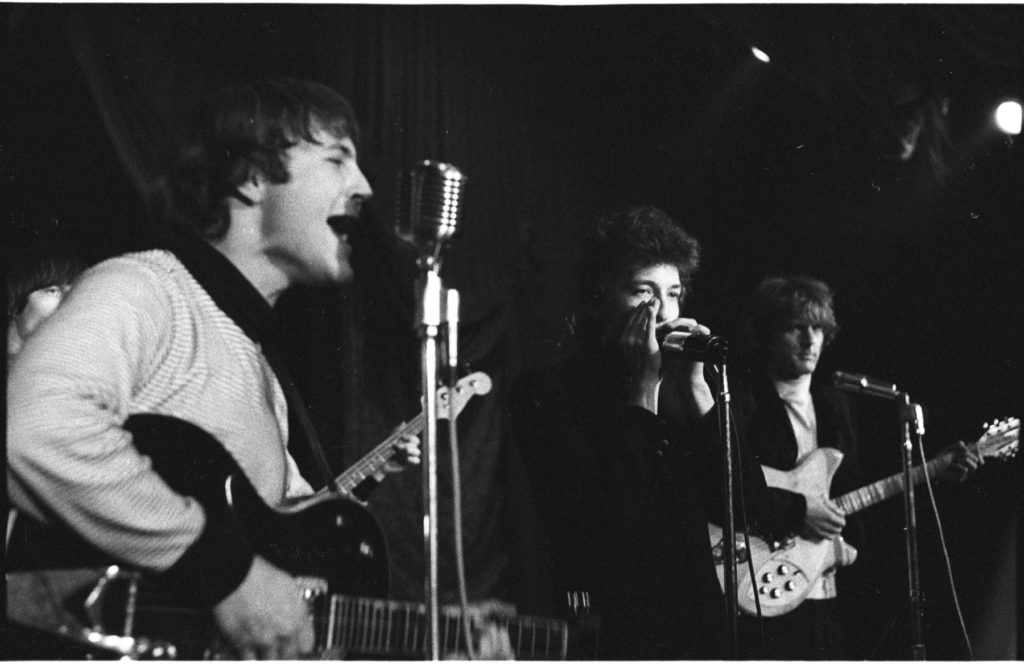
David Crosby, Bob Dylan, Roger (then Jim McGuinn) 1965. The Byrds in Hollywood at Ciro's nightclub. Photo by Jim Dickson, Courtesy of the Henry Diltz archives and librarian Gary Strobl
“David is an incredible singer for harmonies and he’s written some wonderful songs as well. I also really appreciated his rhythm guitar work. I thought he had a great command of the rhythm part of it and also finding interesting chords and progressions.
“We sang together well. I give the credit to Crosby. He was brilliant at devising these harmony parts that were not strict third, fourth or fifth improvisational combination of the three. That’s what makes the Byrds’ harmonies.”
In our 2021 conversation, Crosby discussed the influence of jazz and classical music on his songwriting and how horn players informed his choices of melodies and phrasing.
In 1963 Crosby witnessed a recital by saxophonist John Coltrane in Chicago at a venue named McKie’s. David was blown away by Coltrane’s intense sax solos not just on stage but also earlier in the club’s bathroom where Coltrane was readying for the show.
Miles Davis later recorded a version Crosby’s song “Guinnevere.” The Byrds and Davis shared a booking agent Benny Shapiro who also owned The Renaissance Club in Hollywood.
Davis also played a part in getting the Byrds inked to the Columbia Records label. During 1964-1965 Crosby and the Byrds had the good fortune to develop their unique sound with record producer and their co-manager Jim Dickson, spending many months honing their skills at World Pacific Studios on 3rd Street in Los Angeles, owned by Dick Bock, who issued seminal jazz albums on his Pacific Jazz label and LP’s in the US by Ravi Shankar.
In 1965, Aura, a subsidiary label of Bock’s company released three singles by jazz-fueled Rick and the Ravens in 1965, an outfit helmed by keyboardist Ray Manzarek.
Crosby might have sung a background vocal on Rick and the Ravens’ “Henrietta.” The group eventually evolved into the Doors. The Byrds and Rick and the Ravens incubated at Bock’s jazz-soaked studio.
In a May 2017 Tweet, free speech advocate Crosby offered a highly controversial opinion on the musicianship of the recently departed Manzarek while dismissing Ray’s musical legacy. “I thought he was really unmusical and clumsy.”
During our 2021 interview, Crosby detailed and reinforced his relationship with jazz.
“I was a young folkie musician,” revealed David. “My brother played a lot of fifties jazz. I got turned on to jazz long before I got turned on to pop or rock ‘n’ roll. They played me Gerry Mulligan, Chet Baker, Dave Brubeck, Bill Evans, all of those guys in the late fifties. And more obscure stuff like Cal Tjader. J.J. Johnson. All jazz.
“I get to a point where my head starts to open up a bit and I started playing guitar and getting more interesting on it. I’m starting to listen to pop music and I realized those chords that I really liked they were a little further along. And I started hearing some people using chords like that. And I wanted to go that direction.
“Later the minute that I heard Steely Dan I felt that was somebody else out there that hears the same shit that I do. The minute what I heard what Walter and Donald did. I was like their brother. I wanted to move next door and pitch a pup tent on their lawn, because that was very jazzy. Very strongly jazz influenced. And much more intense and sophisticated than the pop music I had grown up with.
“When we started the Byrds, man, there were other people around town. Paul Revere & the Raiders. We’re tallkin’ primitive shit, guys dancing on their amps in uniforms. I mean, come on. (Laughs). This is a different world. And I hear Steely Dan. Man do I wish I was in that band. And other bands came along as well as Michael Hedges. Another one. Strongly jazz influenced but strongly classically influenced too.
“And I gotta say that is really where it came from to me. I listened to a ton of classical music from my parents and folk music from my parents and jazz music from my brother. My parents played classical music every Sunday of my life. And that’s what did it. I knew those chords were out there and I was lookin’ for ‘em.
“The Weavers and folk singers who could really do it and really had something to say. Those people taught us a whole lot.”
Crosby’s recordings of “Laughing” and “Triad” are incorporated in the new Déjà Vu package. He commented about these tracks.
‘“Laughing.’ The Byrds went over to England in 1965. And, of course, our heroes were the Beatles. And they came to hear us and were really nice to us. They were friendly and very real and not at all star people. None of that. They drove us home from gigs and came to gigs more than once and had us over to houses for dinner and to parties. They were really nice cats.
“I was very taken with George. I liked him a lot. Always did, right from the start. Very sincere. Very friendly and trying hard to be a decent human being. And that appeals to me no end. I became friends with George. So, I had just been turned on to Ravi Shankar by a friend in the States. And I had an album by Ravi in my suitcase. I gave it to George,” he recalled.
“Now that had repercussions. George told me later that I turned him onto Indian music. I have trouble believing that. I think there were other people who helped do that. But, that’s what he told me. God bless me. George liked Indian music, got interested in it and wound up going to India. When he was in India he met a guru, a teacher that he liked.
“Later we were talking and he told me about this guy and he told me about this guy and said he found somebody who might know some of the answers. George was smitten. Well, I’m a very skeptical person about that, always have been. The minute someone tells me they have God’s phone number and address I kind of back off. I don’t believe in that. I wanted to say to George, ‘Oh man, come on, take it with a grain of salt. The guy may know something but don’t bet your whole month’s rent.’ I couldn’t do it. It was George…And I just couldn’t give him that kind of advice. And I said I I’ve thought that I thought that I knew what the answer was and the truth is the closest I came to it was laughing in the sun. And that was a song I wrote to George.”
Crosby’s “Triad,” a 1967 composition about a threesome and sexual freedom occurring at Crosby’s Beverly Glen home in Southern California is heard on the 2021 configuration of Déjà Vu.
Decades ago it was presented to the Byrds for potential inclusion on their LP The Notorious Byrd Brothers, recorded and rejected, later surfacing in 1971 on CSN&Y’s 4 Way Street. In 1968 Jefferson Airplane did a cover of it guided by Grace Slick’s haunting vocal on Crown of Creation. In 2006 the Byrds’ recording of “Triad” appeared on the Columbia/Legacy label’s There Is A Season box set.
“The reason the French call it manage a trois is they’ve been doing it for a long time,” he emphasized. “It’s not controversial. I think there are people who are very straight-laced, some of it for religious reasons and some of them because they are squares. And for them the idea of three people making love at the same time is not only strange but outrageous, terrible and offensive. I don’t feel that way. Those things are very deeply seeded, people’s reactions to sex and religions.”
Portions of this article were first published in Record Collector News magazine.
Harvey Kubernik is the author of 19 books, including Canyon Of Dreams: The Magic And The Music Of Laurel Canyon, Turn Up The Radio! Rock, Pop and Roll In Los Angeles 1956-1972 and a study on Neil Young, Heart of Gold.
Sterling/Barnes and Noble in 2018 published Harvey and brother Kenneth Kubernik’s The Story Of The Band: From Big Pink To The Last Waltz. For October 2021 they are writing and assembling a multi-narrative book on Jimi Hendrix for the same publisher.
Otherworld Cottage Industries had just published Harvey Kubernik’s 500-page book, Docs That Rock, Music That Matters, featuring his interviews with D.A. Pennebaker, Albert Maysles, Murray Lerner, Morgan Neville, Henry Diltz, Graham Nash, Chris Hillman, Roger McGuinn, Mary Wilson, Michael Lindsay-Hogg, Andrew Loog Oldham, John Ridley, Curtis Hanson, Dick Clark, Travis Pike, Allan Arkush, and David Leaf, among others.
This century Harvey wrote the liner note booklets to the CD re-releases of Carole King’s Tapestry, Allen Ginsberg’s Kaddish, Elvis Presley The ’68 Comeback Special and The Ramones’ End of the Century. Kubernik and Andrew Loog Oldham wrote the liner essays to The Essential Carole King.
Kubernik, Henry Diltz and Gary Strobl collaborated with ABC-TV in 2013 for their Emmy-winning one hour Eye on L.A. Legends of Laurel Canyon hosted by Tina Malave. In 2020 Harvey served as Consultant on Laurel Canyon: A Place In Time documentary directed by Alison Ellwood which debuted in May 2020 on the EPIX/MGM television channel.
Kubernik was interviewed last decade by director/producer Neil Norman for his GNP Crescendo documentary, The Seeds: Pushin’ Too Hard. Jan Savage and Daryl Hooper original members of the Seeds participated along with Bruce Johnston of the Beach Boys, Iggy Pop, Kim Fowley, Jim Salzer, the Bangles, photographer Ed Caraeff, Mark Weitz of the Strawberry Alarm Clock and Johnny Echols of Love. Miss Pamela Des Barres supplied the narration.
This decade Harvey was filmed for the currently in-production documentary about former Hollywood landmark Gold Star Recording Studio and co-owner/engineer Stan Ross produced and directed by Brad Ross and Jonathan Rosenberg. Brian Wilson, Herb Alpert, Richie Furay, Darlene Love, Mike Curb, Chris Montez, Bill Medley, Don Randi, Hal Blaine, Shel Talmy, Richard Sherman, Don Peake, Kim Fowley, Johnny Echols, Gloria Jones, Slim Jim Phantom, Paul Body, Bill Inglot, Carol Kaye, Melanie Vannem, Marky Ramone, David Kessel and Steven Van Zandt have been lensed.

